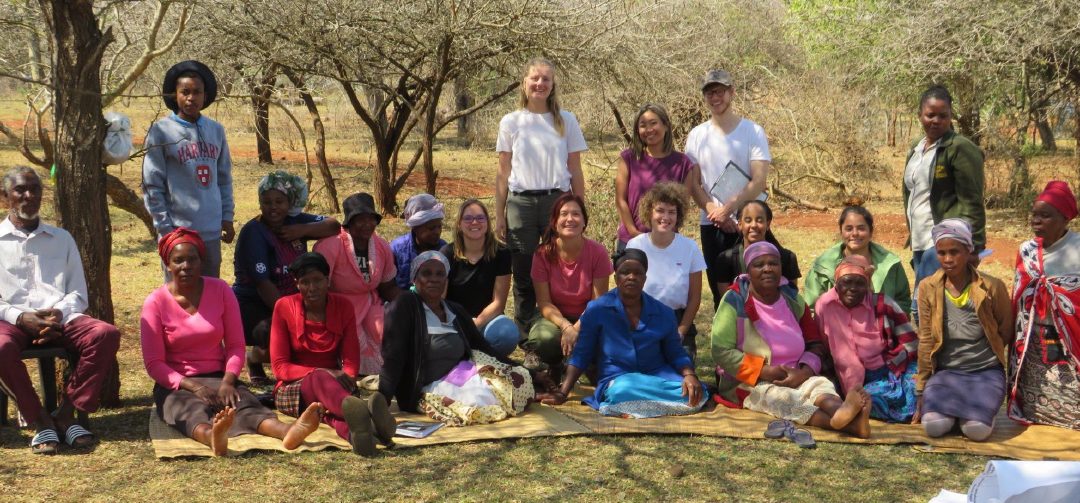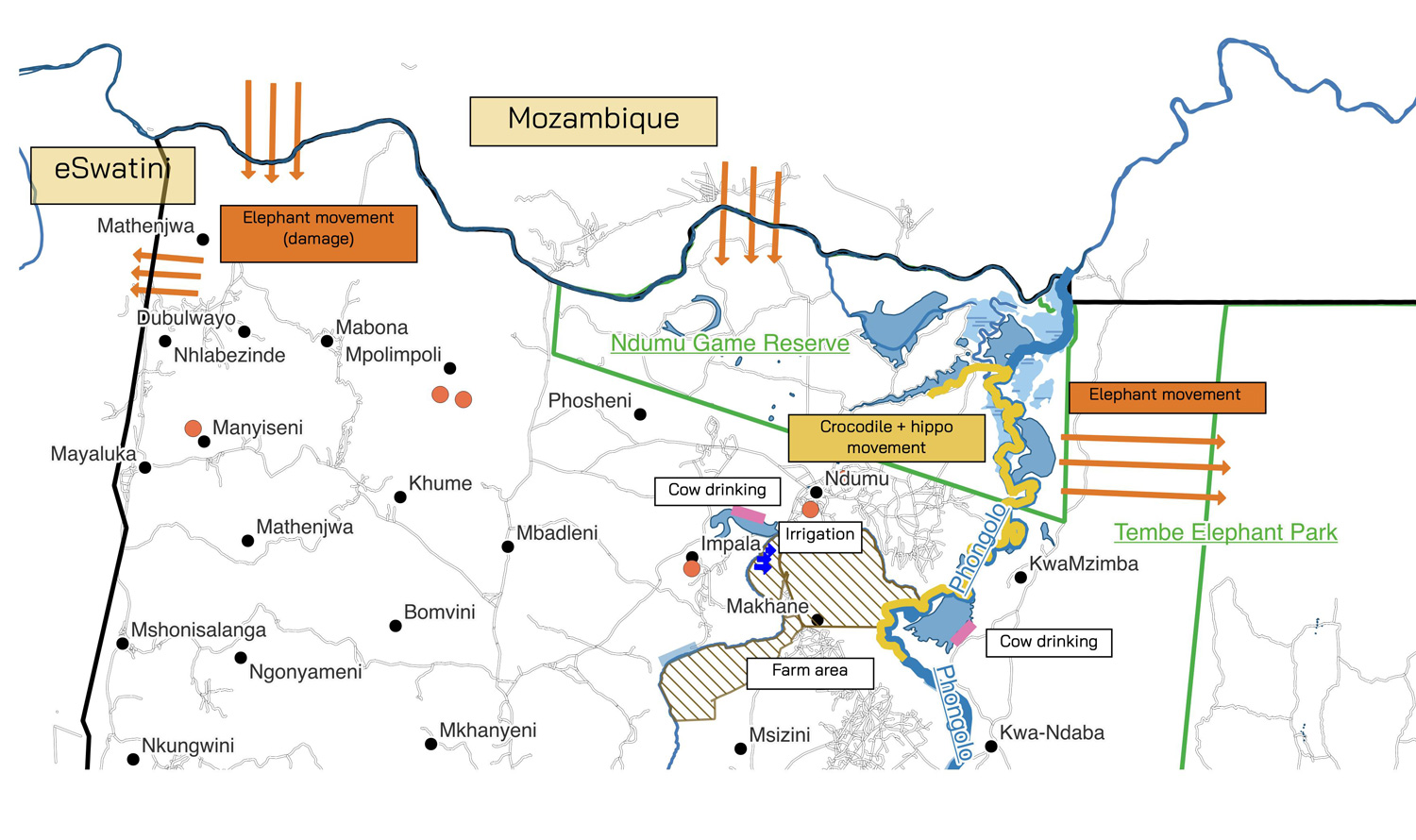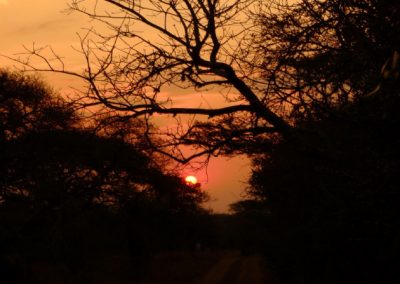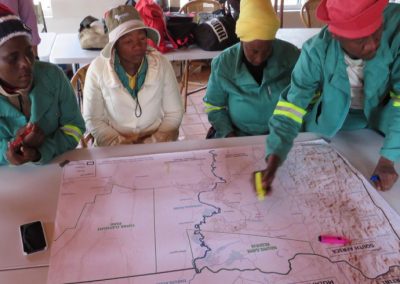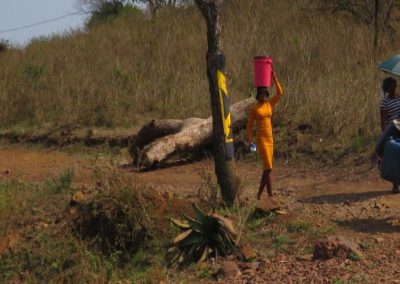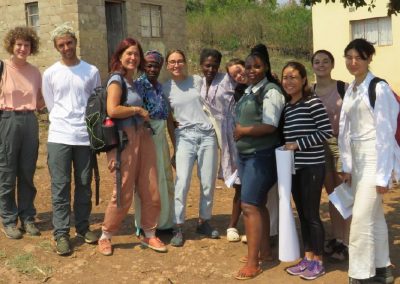By Maria Garalde, Elisabeth Goes d’Huart, Anna Paul, Vania Martinez, Valentina Cimmino, Noémie De Vriendt
What did the Climate Risk Group experience in the NDUMO Game Reserve?
Climate change. We hear about climate change every day and in every class of this master but getting the chance to see in person the impacts that it has on livelihoods and human-wildlife interactions was what we came here for. Our group, the only girl power group of the Living Lab, had a very clear objective: create a climate risk and vulnerability assessment of the area. We wanted to know how the global issue of climate change is impacting this region with droughts, heavy rains, and changing weather patterns. We wanted to know how this was affecting the livelihoods of the communities — their access to water, agricultural practices, maintenance of pasture and livestock, and the quality of life in the region. We wanted to know if all these climatic dynamics were changing wildlife behaviors and having a significant effect on human-wildlife interactions by interacting with communities in areas where wild animals go (hippo’s, crocodiles, elephants, hyenas). To do that, we based our methodology on field observation, interviews with experts, and focus group discussions with communities using a participatory map to understand the changes in dynamics of people’s daily life. Creating a complete impact chain for this assessment was not an easy task. Every day, each interview or focus group would add new elements to the picture and revealed that the reality was complex, but at the same time that everything was interconnected.
Research findings and risks. The main risk was water scarcity. We have discovered that drought has been happening more often compared to past years and this leads to water shortage due to the pans/rivers drying up, affecting the water resources in Maputaland. Consequently, due to the prevalence of drought in the region in the recent years, human and wildlife interactions have been occurring more frequently, especially at the water sources such as the Phongolo river. Not to mention that the lack of proper water infrastructure and maintenance is exacerbating the problems related to water in the area. The Phongolo is crucial because it is the biggest water system in the area, however, a lot of people live far from the river, so this factor also contributes to the water problem of the communities. Another risk was related to food insecurity. On the one hand, increasing livestock in the area creates problems of overgrazing and water sources, and on the other hand agricultural land is affected by droughts and floods leading to food shortages. Our last point of research was about human-wildlife interactions. The increasing presence of wild animals and shifting movement of wildlife in the Ndumo region poses as a problem for communities, which has resulted in broken fences, destruction of crops, death of cattle, and disturbance to the communities accessing water for washing clothes or fishing. However, the presence of wildlife within the perimeter of the communities and the issue of food insecurity has also led to the increasing occurrence of poaching in the area. For the last risk, we tried to map the dynamics explained by the local communities to understand how wildlife affects the livestock and interferes with farming activities. One common point to these 3 risks is that we identified a clear difference between communities living in the mountains, less access to water so less human-wildlife interactions (or from other types, with snakes for example), and communities living close to the Phongolo River, suffering from hippos and crocodiles’ presence but having more water supply.
General conclusions. Although the task was very complex, we tried our best to build up this research project. Our conclusions, so far, are that climate change is exacerbating economic instability and transforming social dimensions in the area. We noticed some different positive local efforts from the communities to mitigate climate change and to cope with climatic issues, such as communal gardens, but we were lacking some perspectives for the future. It was hard for them to tell what adaptation strategies they have for future droughts or floods, how they are going to manage human-wildlife interactions or even what type of help would be useful to face the coming events. Regarding the human-wildlife interactions and their changing behaviors, it is yet to be determined by further research whether it is only because of climate change or if urbanization issues play a role as well. Nevertheless, no matter what, we learned so much during this fieldwork and we unanimously agree on the fact that this was an amazing learning experience.
If you want to know more about that amazing learning experience, keep reading!
New environment. For most of us, it was our first time in South Africa, and it was a whole new world that welcomed us with open arms. Being disconnected from the rest of the world for 2 weeks was a change that we all had to adapt to. Undoubtedly, it was a challenge for all of us to be in a new environment with zero connection, load shedding, 7AM call time every day, and 24/7 human interaction, but we went through it together, allowed us to get to know each other better, and gave us the sense of satisfaction of overcoming obstacles that we encountered as a group.
Definitely a once-in-a-lifetime experience. The breath-taking nature that surrounded us in South Africa made it easy to forget the fast-paced lives that we all had in Belgium. It was a unique experience that allowed us to appreciate the privileges that we have been given to enjoy every day. Every day was a different adventure – from seeing giraffes, nyalas, and monkeys at the campsite to seeing zebras, hippos, crocodiles, and rare birds during the fieldwork.
Unforgettable memories. Pictures are worth a thousand words, but the memories of Living Lab will remain with us for a lifetime. The various moments that we were able to encounter would be hard to reproduce, and in that sense, the countless photos that were taken are able to capture those and one day, remind us of this rare experience that we were able to take part of.
“Most things are forgotten over time… We’re so caught up in our everyday lives that events of the past are no longer in orbit around our minds. There are just too many things we have to think about every day, too many new things we have to learn. But still, no matter how much time passes, no matter what takes place in the interim, there are some things we can never assign to oblivion, memories we can never rub away. They remain with us forever, like a touchstone.”
-Haruki Murakami
Mix of cultures and perspectives. We were able to interact with local communities within the Kwazulu- Natal region and know more about their lives, their culture, and their language/s. They were very warm and welcoming towards us and were open to sharing how they go about their lives on a daily basis. It was also fun to be with the students of NWU because they shared a lot of things about their country. Aside from the socio-cultural aspect of the Living Lab, we were also able to work on our group dynamics, fuse different ideas, discover our strengths and weaknesses, and push ourselves during the endless brainstorming sessions to end up with a cohesive project.
Opening our minds. For some of us in the program, fieldwork research was just something that we talked and read about, but the Living Lab was a good opportunity to experience it on-the-ground. It was a hands-on experience that allowed us to experiment with various methods of working and gain practical skills. All of us had the chance to delve into interdisciplinary work and try natural science research techniques such as sorting out macro and micro invertebrates, determining species using a microscope, measuring land plots, identifying tree species, etc. The 2 weeks of Living Lab were constant waves of ideas, opinions, and solutions. The field work in South Africa allowed us to think outside of the box and expand our knowledge in many aspects.
Participatory Mapping with local community members © Climate Risk & Vulnerability group
Participatory Mapping with local community members © Climate Risk & Vulnerability group
Strong women of the KZN © Climate Risk & Vulnerability group
Strong women of the KZN © Climate Risk & Vulnerability group
